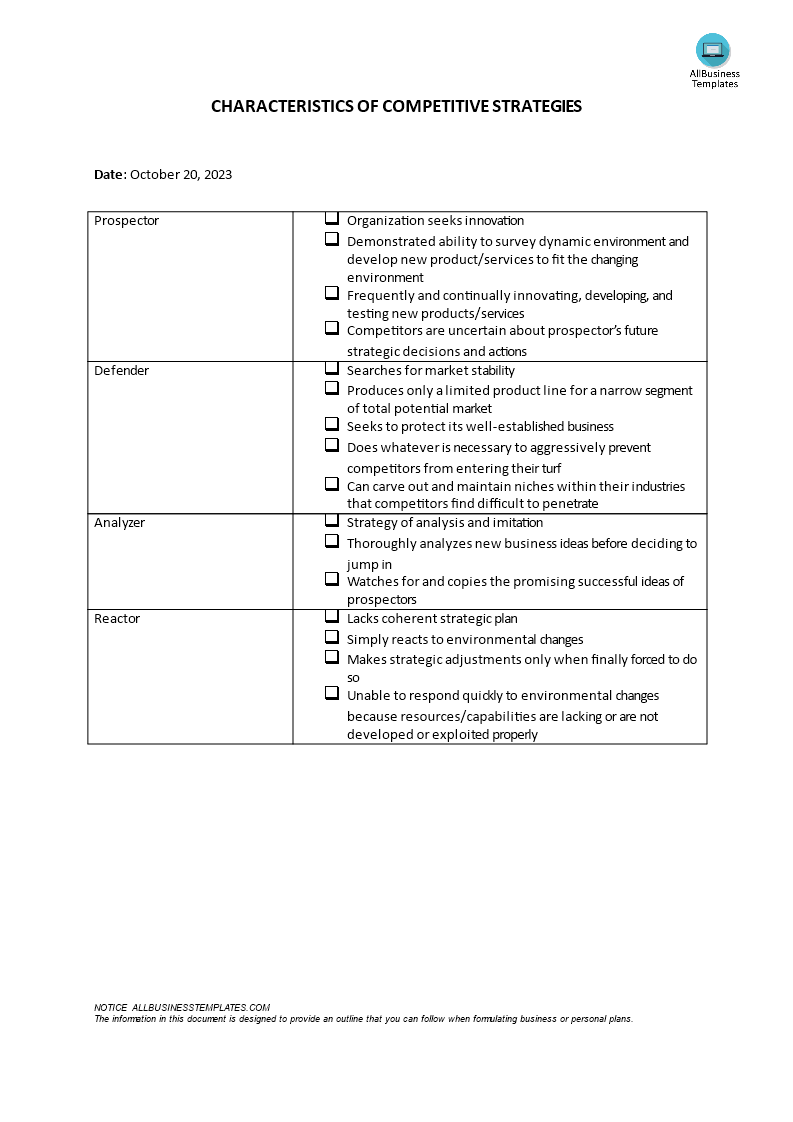Characteristics of Competitive Strategies
Sponsored Link高级模板 保存,填空,打印,三步搞定!

下载 下载 How to make a competitive strategy? Do you need a Characteristics of Competitive Strategies overview? We provide a detailed breakdown of the different elements, including pricing, marketing, and distribution strategies. Get our sample template now!
只有今天: USD 2.99
点击购买

可用的免费文件格式:
微软的词 (.docx)- 本文档已通过专业认证
- 100%可定制
- 这是一个数字下载 (24.6 kB)
- 语: English
- 付款完成后,您将收到包含该文件的电子邮件。
Sponsored Link
How to make a competitive strategy? Do you need a Characteristics of Competitive Strategies overview? Our template contains a comprehensive overview of the key characteristics that make up a competitive strategy. We provide a detailed breakdown of the different elements, including pricing, marketing, and distribution strategies. Get our sample template now!
Competitive strategies are the approaches and plans that businesses use to gain a competitive advantage over their rivals in the marketplace. These strategies are essential for achieving business objectives, increasing market share, and ultimately achieving long-term success.
Here are some key characteristics of competitive strategies:
- Focus on Competitive Advantage: Competitive strategies are designed to create and sustain a competitive advantage. This advantage can be based on factors such as cost leadership, product differentiation, superior customer service, or innovation.
- Long-Term Orientation: Competitive strategies are not short-term tactics but rather long-term plans. They involve a sustained effort to outperform competitors over an extended period.
- Adaptation to Market Conditions: Effective competitive strategies are flexible and adaptable to changing market conditions, consumer preferences, and competitive threats. Businesses must continuously assess and adjust their strategies as needed.
- Market Positioning: Competitive strategies involve positioning a company's products or services in a way that distinguishes them from those of competitors. This positioning can target specific customer segments or market niches.
- Clear Objectives: Competitive strategies should have clear and measurable objectives. These objectives may include increasing market share, boosting profitability, expanding into new markets, or launching new products.
- Cost and Efficiency Considerations: Some competitive strategies focus on achieving cost leadership by minimizing production costs and operational inefficiencies. Cost reduction efforts can lead to competitive pricing or higher profit margins.
- Innovation and Differentiation: Others emphasize product innovation and differentiation. These strategies aim to offer unique features or benefits that set the company's products apart from competitors.
- Customer-Centric Approach: Customer needs and preferences play a central role in competitive strategies. Successful strategies often involve understanding and meeting customer demands more effectively than rivals.
- Competitor Analysis: Competitive strategies involve a thorough analysis of competitors' strengths and weaknesses. This analysis helps businesses identify opportunities to exploit rivals' vulnerabilities.
- Risk Management: Businesses must assess the risks associated with their chosen competitive strategies. Strategies that involve significant risk may also offer substantial rewards, but they require careful risk management.
- Resource Allocation: Competitive strategies often require the allocation of resources, including financial, human, and technological resources. Effective resource allocation is critical for strategy execution.
- Monitoring and Evaluation: Continuous monitoring and evaluation of competitive strategies are essential to determine their effectiveness. Metrics and key performance indicators (KPIs) are used to assess progress toward strategic goals.
- Ethical Considerations: Ethical principles and legal compliance are integral to competitive strategies. Unethical or illegal actions can harm a company's reputation and result in legal consequences.
- Global Perspective: In today's globalized economy, competitive strategies often consider opportunities and challenges in international markets. Expanding beyond domestic borders can be part of a company's strategy.
- Sustainability and Social Responsibility: Many businesses incorporate sustainability and social responsibility into their competitive strategies to address environmental and societal concerns. This can enhance their reputation and competitiveness.
Competitive strategies are dynamic and can evolve over time as market conditions change. Businesses must be agile and willing to adjust their strategies to maintain or enhance their competitive position.
Download this professional characteristic of the Competitive Strategies template now!
DISCLAIMER
Nothing on this site shall be considered legal advice and no attorney-client relationship is established.
发表评论。 如果您有任何问题或意见,请随时在下面发布
相关文件
Sponsored Link
